
Making low-sugar jam without pectin
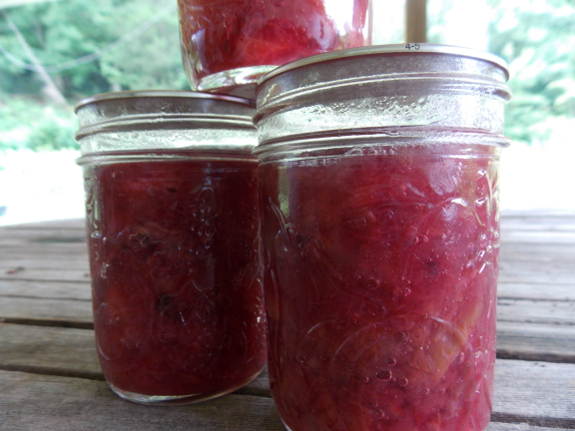
For the first time
this year, I'm realizing that it's possible to reach the point
where I've made enough fruit
leather and freezer
jam, have gorged myself on fresh, and still have an excess
of summer fruits. I plan to can whole peaches once the
fruits from our late tree are entirely ripe, but the
half-ripe-but-brown-rot-affected peaches also need a home, and
those seemed like a good candidate for jam.
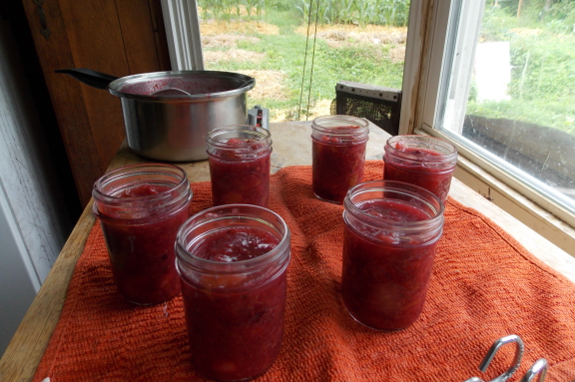
We don't eat much
jam, partly because we've eliminated bread from our diet, but more
because jam is just so sweet that it seems like a dessert, even
when mixed with yogurt. Despite the name, the "low-sugar",
cooked jam recipes inside the SureJell box call for 3 cups of
sugar for every 4.5 cups of peaches, and I wanted to go much lower
than that. So I started reading up on long-boil jams, where
the combination of evaporating off water and candying the sugar
produces a gel without the sugar-pectin reaction.
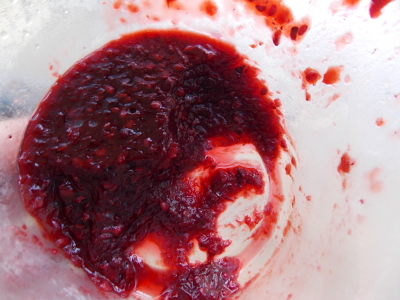 For my first experiment, I
used 1 cup of sugar, a box of low-sugar pectin, 1.5 cups of
peaches, and 3 cups of blackberries. The result was a very
well-set jam (although far too seedy). I didn't have any
canning lids on hand, though, so I just stuffed this first
experiment in the freezer.
For my first experiment, I
used 1 cup of sugar, a box of low-sugar pectin, 1.5 cups of
peaches, and 3 cups of blackberries. The result was a very
well-set jam (although far too seedy). I didn't have any
canning lids on hand, though, so I just stuffed this first
experiment in the freezer.
After sending Mark to
town for canning lids and accumulating another four or five cups
or so of problematic, unripe peaches, I decided to try again, this
time without pectin. I cut up the peaches into big chunks
(instead of sending them through the food processor the way I did
last time), added about half a cup of blackberries and 1 cup of
sugar, and tossed in half a cup of the seedy blackberry jam from
round 1. (So I guess this experiment did involve a little
bit of store-bought pectin.)
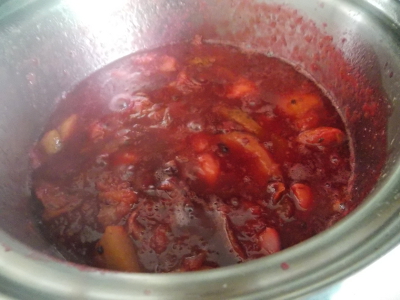 As the jam was cooking, I
started looking up instructions for canning jam. The
SureJell recipes simply call for sterilizing the jars, pouring the
hot jam in, then putting on the lids, with no further
processing. While that might have been acceptable even
without the pectin, I wasn't sure enough to give it a try.
As the jam was cooking, I
started looking up instructions for canning jam. The
SureJell recipes simply call for sterilizing the jars, pouring the
hot jam in, then putting on the lids, with no further
processing. While that might have been acceptable even
without the pectin, I wasn't sure enough to give it a try.
Meanwhile, extension service websites tell me that sugar isn't
necessary for preventing spoilage --- that its purpose in jam is
merely to maintain the color and to produce the gelatinous
consistency. But they also recommend processing any jam for
5 minutes in a hot water bath if you live below 1,000 feet in
elevation, and for 10 minutes if you live between 1,000 and 6,000
feet.
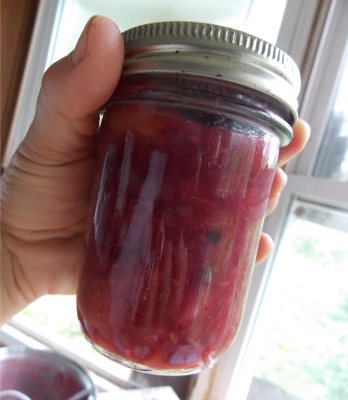 Despite this data, I was
still stumped because the aforementioned extension service
websites assumed I'd be adding pectin of some sort, not using the
older, boil-down method of jamming. To be entirely safe, I
figured I could use the processing guidelines for canning plain
fruit, but I couldn't find any data on how many minutes to process
peaches and blackberries in cup-size jars. I did, however,
read that prolonged boiling weakens pectin, so I opted to stick to
the extension service's 10-minute guidelines after all.
Despite this data, I was
still stumped because the aforementioned extension service
websites assumed I'd be adding pectin of some sort, not using the
older, boil-down method of jamming. To be entirely safe, I
figured I could use the processing guidelines for canning plain
fruit, but I couldn't find any data on how many minutes to process
peaches and blackberries in cup-size jars. I did, however,
read that prolonged boiling weakens pectin, so I opted to stick to
the extension service's 10-minute guidelines after all.
The result is six
little jars of light-maroon jam, which seems to have set up pretty
well as it cooled. I guess I won't know for sure if my
experiment was a success until I wait a few weeks and open up a
jar to see what's going on inside.
I'm very new to
recipe-less jam-making, so I'd love to hear about your
experiences. Any other favorite ways to process small
amounts of excess fruit, or (looking ahead), lots and lots of
peaches?
Want more in-depth information? Browse through our books.
Or explore more posts by date or by subject.
About us: Anna Hess and Mark Hamilton spent over a decade living self-sufficiently in the mountains of Virginia before moving north to start over from scratch in the foothills of Ohio. They've experimented with permaculture, no-till gardening, trailersteading, home-based microbusinesses and much more, writing about their adventures in both blogs and books.
Want to be notified when new comments are posted on this page? Click on the RSS button after you add a comment to subscribe to the comment feed, or simply check the box beside "email replies to me" while writing your comment.

In the past I made a fair bit of jam, but am waiting for more fruit at our new house (soon!--29 peaches this year, pears should bear next year, and lots of raspberries growing, never enough strawberries).
I would use diced apples to provide pectin for my raspberry jams. It would set up very well.
Jams that are cooked for a long time have a much different taste than ones cooked for a shorter period. Much more jammy, but less fresh tasting. I'm not certain what is different, but my mom's raspberrry jam is much fresher and brighter tasting. My kids (we always get some at Christmas) will eat hers straight from a spoon.
Even if you won't eat all your jam, it makes wonderful gifts. Most store bought jams are all sugar and corn syrup, with just a little bit of fruit flavoring. Your friends will love the difference.
Basically all that the pectin does is help you reach 221 F (I think that is is - basically a few degrees above boiling) sooner. Once the jam reaches this point it will set/preserve.
Once you make the jam you just need to boil it for 5/10 minutes for 1/2 pint size (depending on altitude). Then it is preserved and you can keep it sitting on the self.
Once you get into canning it is another great way to preserve fruit for later eating. We love eating peaches in the middle of winter :).
We also have been preserving using honey instead of sugar. This works well but does take some work to get right. But the peaches/other soft fruit are always done with a "light syrup" made from honey.
I would second the other comments on the Pomona's Pectin. It also makes it easier to use sweeteners other than white sugar. (...like if you have a bunch of honey for some reason...)
Also, on using small amounts of excess fruit: there's "The Complete Book of Small-Batch Preserving" by Ellie Topp and Margaret Howard. It has a lot of recipes; we haven't tried them all, but some of them are pretty good.